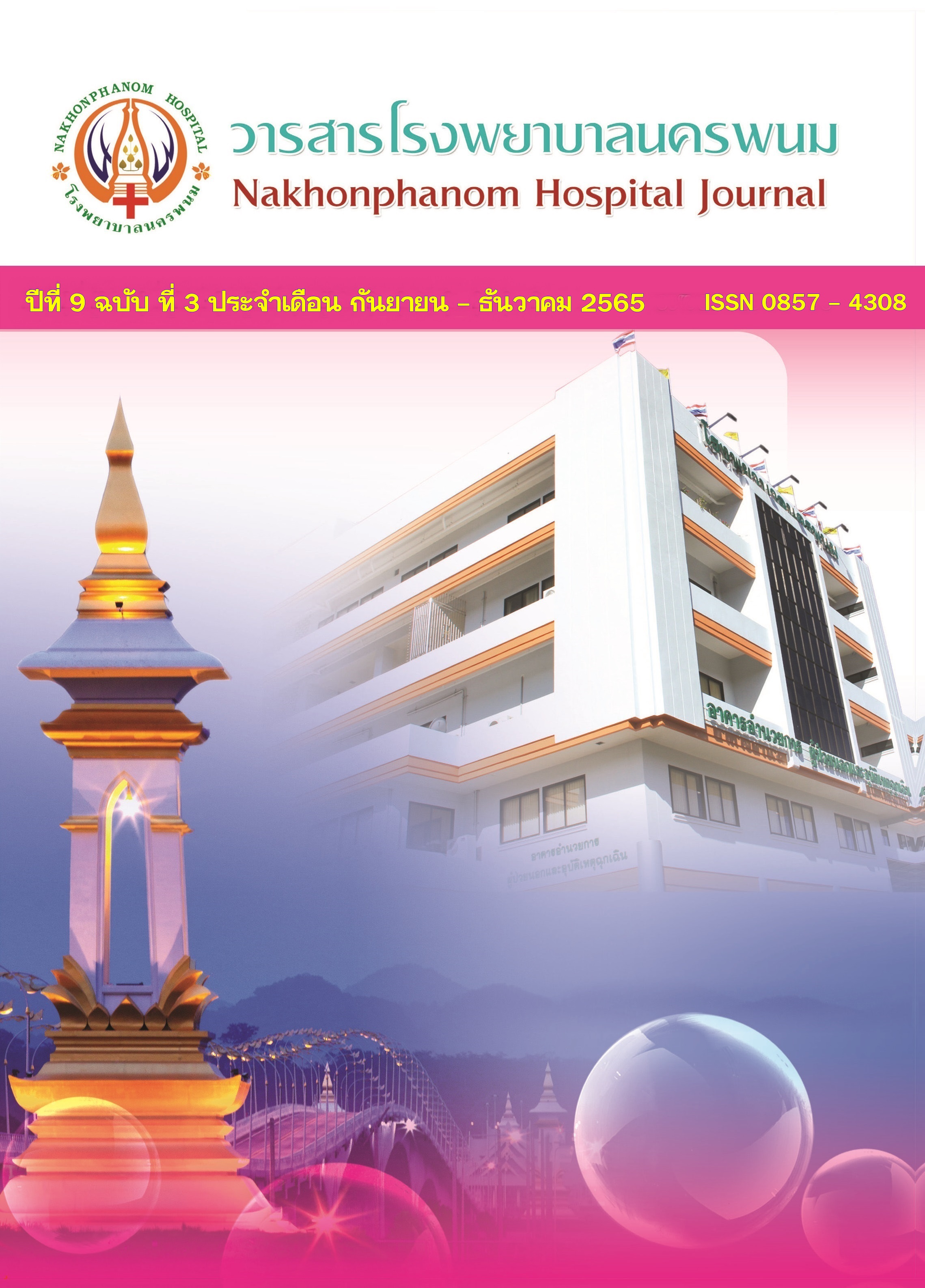อัตราการรอดชีพและปัจจัยที่มีผลต่อการรอดชีพ 30 วันของผู้ป่วยโรคท่อทางเดินน้ำดีอักเสบเฉียบพลัน ที่ได้รับการส่องกล้องท่อน้ำดีในโรงพยาบาลชุมแพ
คำสำคัญ:
การรอดชีพ 30 วัน, ผู้ป่วยโรคท่อทางเดินน้ำดีอักเสบเฉียบพลัน, การส่องกล้องท่อน้ำดีบทคัดย่อ
วัตถุประสงค์: ศึกษาอัตราการรอดชีพและปัจจัยที่มีผลต่อการรอดชีพ 30 วันของผู้ป่วยโรคท่อทางเดินน้ำดีอักเสบเฉียบพลันที่ได้รับการส่องกล้องท่อน้ำดีในโรงพยาบาลชุมแพ
วัสดุและวิธีการ: การศึกษานี้เป็นการศึกษาแบบ Retrospective Study โดยประชากรที่ใช้ในการศึกษาครั้งนี้เป็นผู้ป่วยโรคท่อทางเดินน้ำดีอักเสบเฉียบพลัน ที่เข้ามารักษาโรงพยาบาลชุมแพ อำเภอชุมแพ จังหวัดขอนแก่น ระหว่างวันที่ 1 มกราคม 2562 ถึงวันที่ 31 มีนาคม 2565 ติดตามผู้ป่วยทุกรายอย่างต่อเนื่องจนกระทั่งทราบสถานะสุดท้ายของชีวิต ถึงวันที่ 30 เมษายน 2565 ใช้สูตรการคำนวณขนาดตัวอย่างด้วยวิธีประมาณค่าสัดส่วนประชากรกลุ่มเดียว กรณีประชากรขนาดเล็ก ได้ทั้งสิ้น 111 ราย และวิเคราะห์สถิติ Cox regression เพื่ออธิบายความสัมพันธ์โดยนำเสนอค่า Crude hazard ratio, Adjusted hazard ratio โดยกำหนดนัยสำคัญทางสถิติที่ p-value < 0.05 การวิเคราะห์ข้อมูลทั้งหมดใช้โปรแกรม Stata version 10.1
ผลการศึกษา: จากการศึกษาตัวอย่างจำนวน 111 ราย พบว่ามีอัตราการเสียชีวิตภายใน 30 วัน จำนวน 17 ราย คิดเป็นร้อยละ 15.32 เมื่อวิเคราะห์ univariate cox regression พบว่าปัจจัยที่มีผลต่อการรอดชีพ 30 วันของผู้ป่วยโรคท่อทางเดินน้ำดีอักเสบเฉียบพลันที่ได้รับการส่องกล้องท่อน้ำดี ได้แก่ เพศชาย ASA class 4 ผู้ป่วยที่มีโรคร่วมในกลุ่มมะเร็งของท่อทางเดินน้ำดีและตับอ่อน ผู้ป่วยระดับ severe Severity และการรับการรักษาในหอผู้ป่วยวิกฤติ เมื่อวิเคราะห์ปัจจัยเพื่อหาความสัมพันธ์โดยวิเคราะห์ Multiple cox regression พบว่า กลุ่มผู้ป่วยมะเร็งท่อน้ำดีและตับอ่อน ซึ่งป่วยโรคท่อทางเดินน้ำดีอักเสบเฉียบพลัน มีความเสี่ยงต่อการเสียชีวิตภายใน 30 วันมากกว่าคนที่ไม่ได้เป็นมะเร็ง 17.31 เท่า (Adj. Hazard ratio 17.31 p-value <0.01, CI = 3.25-91.95)
ข้อสรุป : การส่องกล้องท่อทางเดินน้ำดีในภาวะท่อทางเดินน้ำดีอักเสบสามารถลดอัตราการเสียชีวิตใน30 วัน อย่างมีนัยสำคัญทางสถิติ โดยเฉพาะสาเหตุจากนิ่วในท่อทางเดินน้ำดี แต่อัตราการเสียชีวิตรวมทุกสาเหตุยังสูง โดยเฉพาะผู้ป่วยที่มีสาเหตุจากมะเร็งท่อทางเดินน้ำดีและตับอ่อนจะมีความเสี่ยงที่สูงยิ่งขึ้น
เอกสารอ้างอิง
Lan Cheong Wah D, Christophi C, Muralidharan V. Acute cholangitis: current concepts. ANZ J Surg. 2017;87(7–8):554–9.
Common Bile Duct Stone - an overview | ScienceDirect Topics [Internet]. [cited 2022 March 24]. Available at: https://www.sciencedirect.com/topics/pharmacology-toxicology-and-pharmaceutical-science/common-bile-duct-stone
Boulay BR, Parepally M. Managing malignant biliary obstruction in pancreas cancer: Choosing the appropriate strategy. World J Gastroenterol WJG. 2014 Jul 28;20(28):9345–53.
Kimura Y, Takada T, Kawarada Y, Nimura Y, Hirata K, Sekimoto M, et al. Definitions, pathophysiology, and epidemiology of acute cholangitis and cholecystitis: Tokyo Guidelines. J Hepatobiliary Pancreat Surg. 2007 Jan;14(1):15–26.
Ahmed M. Acute cholangitis - an update. World J Gastrointest Pathophysiol. 2018 Feb 15;9(1):1–7.
Kiriyama S, Kozaka K, Takada T, Strasberg SM, Pitt HA, Gabata T, et al. Tokyo Guidelines 2018: diagnostic criteria and severity grading of acute cholangitis (with videos). J Hepato-Biliary-Pancreat Sci. 2018;25(1):17–30.
Park N, Lee SH, You MS, Kim JS, Huh G, Chun JW, et al. Optimal timing of endoscopic retrograde cholangiopancreatography for acute cholangitis associated with distal malignant biliary obstruction. BMC Gastroenterol. 2021 April 17;21(1):175.
Tan M, Schaffalitzky de Muckadell OB, Laursen SB. Association between early ERCP and mortality in patients with acute cholangitis. Gastrointest Endosc. 2018 Jan;87(1):185–92.
Florescu V, Pârvuleţu R, Ardelean M, Angelescu M, Angelescu GA, Enciu O, et al. The Emergency Endoscopic Treatment in Acute Cholangitis. Chir Buchar Rom 1990. Feb 2021;116(1):42–50.
Endoscopic Management of Acute Cholangitis. Gastroenterol Hepatol Open Access [Internet]. 2016 Aug 4 [cited 2022 Sep 2];Volume 5(Issue 2). Available at: https://medcraveonline.com/GHOA/GHOA-05-00133.pdf
Miura F, Okamoto K, Takada T, Strasberg SM, Asbun HJ, Pitt HA, et al. Tokyo Guidelines 2018: initial management of acute biliary infection and flowchart for acute cholangitis. J Hepato-Biliary-Pancreat Sci. 2018;25(1):31–40.
Mukai S, Itoi T, Baron TH, Takada T, Strasberg SM, Pitt HA, et al Indications and techniques of biliary drainage for acute cholangitis in updated Tokyo Guidelines 2018. J Hepato-Biliary-Pancreat Sci. 2017;24(10):537–49.
Buxbaum JL, Buitrago C, Lee A, Elmunzer BJ, Riaz A, Ceppa EP, et al. ASGE guideline on the management of cholangitis. Gastrointest Endosc. 2021 Aug 1;94(2):207-221.e14.
Isayama H, Yasuda I, Tan D. Current strategies for endoscopic management of acute cholangitis. Dig Endosc Off J Jpn Gastroenterol Endosc Soc. April 2017;29 Suppl 2:70–7.
Du L, Cen M, Zheng X, Luo L, Siddiqui A, Kim JJ. Timing of Performing Endoscopic Retrograde Cholangiopancreatography and Inpatient Mortality in Acute Cholangitis: A Systematic Review and Meta-Analysis. Clin Transl Gastroenterol. 18 Mar 2020;11(3):e00158.
ดาวน์โหลด
เผยแพร่แล้ว
รูปแบบการอ้างอิง
ฉบับ
ประเภทบทความ
สัญญาอนุญาต
ลิขสิทธิ์ (c) 2022 โรงพยาบาลนครพนม

อนุญาตภายใต้เงื่อนไข Creative Commons Attribution-NonCommercial-NoDerivatives 4.0 International License.
- บทความที่ได้รับการตีพิมพ์ถือเป็นลิขสิทธิ์ของ โรงพยาบาลนครพนม
- ข้อความหรือข้อคิดเห็นต่างๆ เป็นของผู้เขียนบทความนั้นๆ ไม่ใช่ความเห็นของกองบรรณาธิการ



